Content is from Kirkbride et al. 2006Kirkbride et al. 2006:
Kirkbride JH, Jr, Gunn CR, and Dallwitz MJ. 2006. Family guide for fruits and seeds, vers. 1.0. Accessed September 2020-January 2022. URL: https://nt.ars-grin.gov/seedsfruits/keys/frsdfam/index.cfm ., without modification.
Updates are forthcoming.
Fruits: Pistil(s) compound; 1; 1-pistillate; with carpels united. Fruit pericarpium; simplesimple:
fruit formed from a single flower with one pistil, solitary carpel or several fused carpels
; capsulecapsule:
a dry, dehiscent fruit derived from a compound ovary ; loculicidalloculicidal:
; loculicidalloculicidal:
type of capsular dehiscence, opening longitudinally through the locules (compare septicidal)
 capsulecapsule:
capsulecapsule:
a dry, dehiscent fruit derived from a compound ovary ; capsulecapsule:
; capsulecapsule:
a dry, dehiscent fruit derived from a compound ovary not inflated; capsulecapsule:
not inflated; capsulecapsule:
a dry, dehiscent fruit derived from a compound ovary without operculumoperculum:
without operculumoperculum:
a dehiscent cap (or lid) of a seed or fruit that opens during germination or dehiscence
 ; without persistent central column; more than 1 but less than 10-seeded to 25 to less than 50-seeded; 6–30-seeded; from 1–5 cm long to from 5.1–10 cm long; (3–)4(–9) cm long ((3-)4–8(-9)); with 3-carpellate; with carpels united; with carpels remaining united at maturity; with carpels remaining connected at stylestyle:
; without persistent central column; more than 1 but less than 10-seeded to 25 to less than 50-seeded; 6–30-seeded; from 1–5 cm long to from 5.1–10 cm long; (3–)4(–9) cm long ((3-)4–8(-9)); with 3-carpellate; with carpels united; with carpels remaining united at maturity; with carpels remaining connected at stylestyle:
in a flower, the narrow and elongated part of the pistil between the stigma and the ovary; sometimes persisting in fruit ; without sterilesterile:
; without sterilesterile:
lacking male and/or female reproductive parts; also, not producing fruit or seed
 carpels; not sulcatesulcate:
carpels; not sulcatesulcate:
surface relief—having one or more elongate, relatively narrow and shallow depressions or grooves ; apexapex:
; apexapex:
the point farthest from the point of attachment, or the "tip" of an organ beaked; apexapex:
beaked; apexapex:
the point farthest from the point of attachment, or the "tip" of an organ very short beaked; wall chartaceouschartaceous:
very short beaked; wall chartaceouschartaceous:
=papery, papyraceous
; dehiscentdehiscent:
(v. dehisce) splitting open at maturity to release contents (of a fruit) . Dehiscentdehiscent:
. Dehiscentdehiscent:
(v. dehisce) splitting open at maturity to release contents (of a fruit) unit seed(s). Dehiscentdehiscent:
unit seed(s). Dehiscentdehiscent:
(v. dehisce) splitting open at maturity to release contents (of a fruit) passively; linearly; by dorsaldorsal:
passively; linearly; by dorsaldorsal:
abaxial; the back of an organ; the side away from the axis (compare ventral)
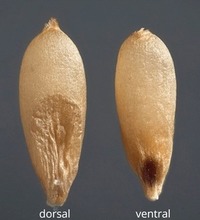 sutures and ventralventral:
sutures and ventralventral:
adaxial; of the side of an organ facing the axis (compare dorsal)
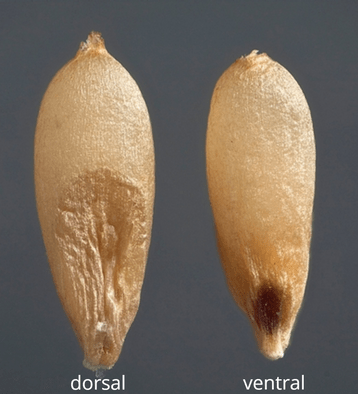 sutures; at apexapex:
sutures; at apexapex:
the point farthest from the point of attachment, or the "tip" of an organ ; and shedding seeds; without replumreplum:
; and shedding seeds; without replumreplum:
the rim, formed by the persistent placentas, and connected by a false septum in Brassicaceae fruits. The fruit valves are attached to this rim and separate from it in dehiscent fruits.
. Epicarpepicarp:
outer layer of fruit wall or pericarp, if divided into layers; note here used synonymously with exocarp brown (all shades); dulldull:
brown (all shades); dulldull:
reflecting only a low proportion of incident light, with no apparent sheen ; durable; not glabrousglabrous:
; durable; not glabrousglabrous:
without hairs
(with hairs); hairs short; hairs dense (assumed); hairs not glandularglandular:
surface relief—covered with small, raised secretory glands, regular or irregularly shaped, translucent or opaque, and maybe distinctly colored ; without armature; without wing(s); without apicalapical:
; without armature; without wing(s); without apicalapical:
at or pertaining to the end of the seed or fruit distal from its point of attachment (i.e., base)
respiratory hole. Endocarpendocarp:
the inner layer of the pericarp, if divided into layers present; not separating from exocarpexocarp:
present; not separating from exocarpexocarp:
outer layer of fruit wall or pericarp, if divided into layers; note here used synonymously with epicarp ; thinthin:
; thinthin:
having or being of relatively little depth
; not splitting into 1-seeded pyrenes; smooth; without wing; without operculumoperculum:
a dehiscent cap (or lid) of a seed or fruit that opens during germination or dehiscence
 ; without secretory cavities; without mechanism for seedling escape; without grooves; without longitudinallongitudinal:
; without secretory cavities; without mechanism for seedling escape; without grooves; without longitudinallongitudinal:
of or relating to length or the lengthwise dimension
ridges. Funiculusfuniculus:
(alt. funicle) stalk connecting the ovule (later seed) to the ovary (later fruit) placenta short; short without seed bearing hooks (retinacula); not persisting in fruit after seed shed.
short; short without seed bearing hooks (retinacula); not persisting in fruit after seed shed.
Seeds: Arilaril:
(broad sense) appendicular structure that wholly or partly envelops a seed and is produced from or a modification of the funicle, raphe, or outer integument; usually fleshy or pulpy, sometimes spongy or tufted-capillate, often brightly colored absent. Seed larger than minute; 5 to less than 10 mm long to 10 to less than 25 mm long; 7–11 mm long; oblongoblong:
absent. Seed larger than minute; 5 to less than 10 mm long to 10 to less than 25 mm long; 7–11 mm long; oblongoblong:
2D shape—much longer than broad with nearly parallel sides, corners are rounded ; in transectiontransection:
; in transectiontransection:
a cross section; representing a plane made by cutting across an organ at a right angle to its length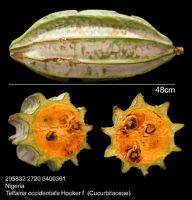 flattened; not bowl shaped; not nutlike; without winglike beakbeak:
flattened; not bowl shaped; not nutlike; without winglike beakbeak:
a usually firm, terminal appendage, sometimes tapered ; without caudatecaudate:
; without caudatecaudate:
tapering to a long, tail-like appendage appendage(s); at maturity without apparent food reserves (essentially because 1-cell thickthick:
appendage(s); at maturity without apparent food reserves (essentially because 1-cell thickthick:
having or being of relatively great depth
), or with food reserves; with endospermendosperm:
nutritive starch- and oil-containing tissue present in many seeds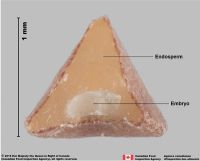 ; without canavanine. Sarcotestasarcotesta:
; without canavanine. Sarcotestasarcotesta:
pulpy or fleshy outer layer of the seed coat, simulates aril absent. Testatesta:
absent. Testatesta:
seed coat
 present; with markedly different marginalmarginal:
present; with markedly different marginalmarginal:
at, on, or close to the margin or border
tissue; marginalmarginal:
at, on, or close to the margin or border
tissue winglike; without fleshyfleshy:
texture—fairly firm and dense, juicy or at least moist, and easily cut
or leatheryleathery:
texture—moderately thick, tough, and very pliable
layer over hard layer; tight; surface unsmooth; surface with merged raised features; surface wrinkledwrinkled:
surface relief—shallow, irregular folds and furrows covering the surface; appearing overall though crumpled and then spread out ; with crease or line separating cotyledons from hypocotyl-radicle; without notch along margin where cotyledons from hypocotyl-radicle tip approach each other; without glands; without bristles; glabrousglabrous:
; with crease or line separating cotyledons from hypocotyl-radicle; without notch along margin where cotyledons from hypocotyl-radicle tip approach each other; without glands; without bristles; glabrousglabrous:
without hairs
; with wing(s) (thin wing longer than seed); 1-winged; with wing encompassing seed; with wing(s) solid; with solid wing(s) similar to testatesta:
seed coat
 ; without collar; without operculumoperculum:
; without collar; without operculumoperculum:
a dehiscent cap (or lid) of a seed or fruit that opens during germination or dehiscence
 ; colored; monochrome; brown (all shades); fleshyfleshy:
; colored; monochrome; brown (all shades); fleshyfleshy:
texture—fairly firm and dense, juicy or at least moist, and easily cut
(soft pithlike); not becoming mucilaginousmucilaginous:
resembling mucilage; moist and sticky
when wetted; surrounding embryo (endosperm 1-celled thickthick:
having or being of relatively great depth
). Endospermendosperm:
nutritive starch- and oil-containing tissue present in many seeds scant, or trace (1-celled thickthick:
scant, or trace (1-celled thickthick:
having or being of relatively great depth
); without fatty acid containing cyclopropene; without apicalapical:
at or pertaining to the end of the seed or fruit distal from its point of attachment (i.e., base)
lobes; without chlorophyll; without isodiametric faceted surface; without odor. Embryo differentiated from food reserve; well developed; 1 per seed; completely filling testatesta:
seed coat
 (no food reserve); chamber central to wings; 1 times the length of food reserve; at one end of seed not extending into a depression or cup; foliatefoliate:
(no food reserve); chamber central to wings; 1 times the length of food reserve; at one end of seed not extending into a depression or cup; foliatefoliate:
appearing leaf-like
; with investinginvesting:
(of embryo) embryo is nearly or completely filling seed coat, straight, and axile and centric with spatulate cotyledons and covering the stalk for at least half its length; (of cotyledons) cotyledons spatulate and covering the stalk for at least half its length
cotyledons; straight; parallel to seed length; with cotyledons abruptly connected to hypocotyl-radicle; without coleorhiza; without simmondsin; without stomata; not green; with 2 or more cotyledons. Cotyledons 2; well developed; not divaricate; 0.7 times length of embryo; as wide as hypocotyl-radicle; 1 times wider than hypocotyl-radicle; partially concealing hypocotyl-radicle; flat; smooth; with apicesapex:
the point farthest from the point of attachment, or the "tip" of an organ entire; with margins separate; basally cordatecordate:
entire; with margins separate; basally cordatecordate:
2D shape—heart-shaped, with attachment at or near the broad end (compare obcordate)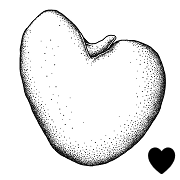 ; equal in size; not punctatepunctate:
; equal in size; not punctatepunctate:
surface relief—dotted with pits or with translucent, sunken glands or with colored dots, similar to pitted dotted.
dotted.
Literature specific to this family: Iltis, H.H. 1999. Setchellanthaceae (Capparales), a new family for a relictual, glucosinolate-producing endemic of the Mexican deserts. Taxon 48:257–275; Tobe, H., S. Carlquist, & H.H. Iltis. 1999. Reproductive anatomy and relationships of Setchellantus caeruleus (Setchellanthaceae). Taxon 48:277–283.